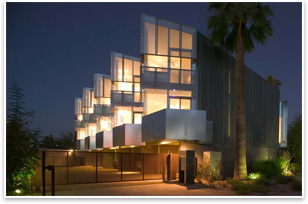|
New AIA Research Report Shows Communities Are Going Green
by Brooks Rainwater
Manager, State and Local Issues and Programs
AIA Government Advocacy
 Summary: American cities are going green and local leaders are charging ahead with innovative sustainability policies. Since 2003, the number of cities with green building programs has increased by more than 400 percent, due to a concerted effort by local political leaders and officials, architects, and others within the design/building industry and grassroots support. Local Leaders in Sustainability: A Study of Green Building Programs in Our Nation’s Communities, a new research effort from the AIA Government Advocacy team, examines the current state of green building laws in American cities as of this year. Summary: American cities are going green and local leaders are charging ahead with innovative sustainability policies. Since 2003, the number of cities with green building programs has increased by more than 400 percent, due to a concerted effort by local political leaders and officials, architects, and others within the design/building industry and grassroots support. Local Leaders in Sustainability: A Study of Green Building Programs in Our Nation’s Communities, a new research effort from the AIA Government Advocacy team, examines the current state of green building laws in American cities as of this year.
 The study offers a tool for communities and other levels of government that seek to design green building programs. It is based on research conducted by the AIA on all American cities with a population greater than 50,000 (661 communities) to spotlight the growth and effectiveness of green building policies. The study was conducted through a set of surveys that sought to garner information on green building programs. The study offers a tool for communities and other levels of government that seek to design green building programs. It is based on research conducted by the AIA on all American cities with a population greater than 50,000 (661 communities) to spotlight the growth and effectiveness of green building policies. The study was conducted through a set of surveys that sought to garner information on green building programs.
The report is divided into five broad sections.
- “Introduction” offers an executive summary, discusses the methodology and organization of the study, and defines commonly used green terms.
- “Study Findings” discusses the typical path to a green building policy, the state of green building nationwide, the regional distribution of programs, current trends, and additional survey responses.
- “Case Studies” examines best practices of green building programs throughout the country.
- “Cities Pushing Ahead” imagines the future of green building and looks at current far-reaching programs that have either just recently begun or are now coming online in the D.C.-to-Boston corridor, California, and the Pacific Northwest.
- “Conclusion” offers a final analysis and recommendations for continued greening.
Key findings
The key findings of this research indicate:
- 1 in 7, or 92, surveyed cities currently have green building programs
- The number improves to 1 in 5 cities by next year with current projections, as an additional 36 cities are currently in an advanced stage of developing green building programs
- 39 percent of citizens, or approximately 42 million Americans, live in cities with green building programs, due to the preponderance of sustainability initiatives in large urban areas.
The study found no single guideline or policy that will be best for all cities. Just as certain design features are more effective depending on the regional climate, certain policies are more effective depending on the political climate. The data did, however, reveal common threads in successful policies, and the case study section helps to highlight the best practices of municipal green building.
 The case study section focuses on six cities— Portland, Ore.; San Francisco; Scottsdale, Ariz.; Chicago; Austin; and Atlanta—with exciting green building programs that can truly be considered local leaders. While there are a number of other equally impressive programs, these communities represent a cross-section of regionally diverse policies that include various unique aspects that are transferable to other developing green programs. The case study section focuses on six cities— Portland, Ore.; San Francisco; Scottsdale, Ariz.; Chicago; Austin; and Atlanta—with exciting green building programs that can truly be considered local leaders. While there are a number of other equally impressive programs, these communities represent a cross-section of regionally diverse policies that include various unique aspects that are transferable to other developing green programs.
Pushing ahead
The study also highlights cities, largely concentrated in California and the D.C.-to-Boston corridor, that are pushing ahead on green building with inventive and far-reaching programs. These cities incorporate green requirements into all or nearly all buildings. Many of these policies are either just now getting off the ground or are being phased in over the next few years. In the Pacific Northwest, for example, a group is finding that the green premium on even LEED Platinum buildings is moving towards parity. As a result, the USGBC’s Cascadia Region has created the Living Building Challenge, which is striving toward designing buildings that are “triple net zero”—using zero net energy and zero net water, thus leading to a zero carbon footprint.
The nation’s local leaders, which have been pushing forward with inventive policies to meet environmental challenges, also have seen green building and sustainability as an economic opportunity as they seek to nurture “green collar” jobs within their communities. The future is green, and the breadth of experience displayed by these communities should prove useful for all levels of government moving forward on green building initiatives.
For more information, read Local Leaders in Sustainability: A Study of Green Building Programs in our Nation’s Communities published on the AIA Government Advocacy Web site.
|




